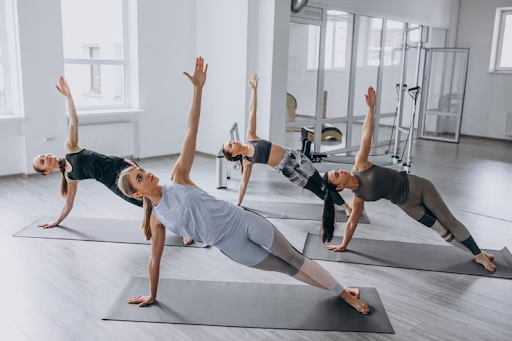Leading a healthy lifestyle can be difficult, particularly when your schedule is packed. To maintain a healthy balance of fitness and nutrition, you must be disciplined, consistent, and willing to make minor adjustments to your daily routine. It’s important to recognize some of the usual reasons people fail to meet their fitness objectives, such as a lack of motivation, impractical expectations, time constraints, and insufficient planning. When starting your fitness journey, it’s important to be aware of these elements because they might have a big impact on your success.
Whatever your lifestyle, we’ll provide you five straightforward suggestions in this article to help you balance your own fitness and diet while attaining your health goals.
Tip #1 Set Realistic Goals
Setting realistic goals is crucial when it comes to balancing personal fitness and nutrition. You want to set goals that are challenging enough to motivate you but not so challenging that they are unattainable. Beginning with basic, doable objectives, gradually up the challenge as you advance. For instance, if you’ve never worked out before, start with pledging to exercise for 30 minutes three times per week. Once you’ve established this routine, you can gradually lengthen your workouts and do them more frequently.
Tip #2 Plan Your Meals Ahead of Time
Planning your meals ahead of time is another essential tip for balancing personal fitness and nutrition. Meal planning enables you to make better food selections and guarantees that you always have wholesome, nourishing meals on hand. Each week, set aside some time to plan your meals and create a checklist. To save time during the week, you can also make some meals in advance, such as breakfast or lunch.
There are many types of meals that can support your individual nutrition and fitness objectives.
- Lean protein meals: Meals that include lean sources of protein like chicken breast, turkey, fish, tofu, and legumes are great for building and repairing muscles, which is important for maintaining an active lifestyle.
- Vegetables and fruits: Meals that include plenty of vegetables and fruits provide essential vitamins, minerals, and fiber that support overall health and well-being.
- Whole grains: Meals that include whole grains like brown rice, quinoa, whole wheat pasta, and oatmeal provide complex carbohydrates that help sustain energy levels and support overall health.
- Healthy fats: Meals that include healthy sources of fat like nuts, seeds, avocado, and olive oil provide important nutrients that support brain function, hormonal balance, and heart health.
Tip #3 Find an Exercise Routine You Enjoy
Finding an exercise routine that you enjoy is essential for staying motivated and consistent. Try out various forms of exercise until you discover one you enjoy the most. You can also mix up your routine by trying new exercises or attending fitness classes. The key is to find an activity that you look forward to doing and that fits into your lifestyle.
The four basic types of exercise you can include in your fitness routine are listed below.
- Endurance Exercise (also known as Aerobic Exercise or Cardiovascular Exercise): Running, cycling, swimming, dancing, and brisk walking are examples of exercises in this category that raise your heart rate and breathing rate. Endurance exercise helps to improve your cardiovascular health, endurance, and stamina.
- Strength Exercise (also known as Resistance Training): This kind of training, which includes weightlifting, push-ups, pull-ups, squats, and lunges, focuses on developing muscle and boosting strength. Strength exercise helps to improve your muscle strength and tone, bone density, and metabolism.
- Balance Exercise: This type of exercise helps to improve your balance, coordination, and stability, such as standing on one foot, heel-to-toe walking, and Tai Chi. Balance exercise helps to prevent falls and injuries, particularly in older adults.
- Flexibility Exercise (also known as Stretching): This type of exercise involves stretching and lengthening your muscles and joints, such as doing yoga poses, Pilates exercises, or static stretches. Flexibility exercise helps to improve your range of motion, prevent injuries, and reduce muscle soreness and stiffness.
Tip #4 Make Time for Exercise
One of the most common reasons people fail to maintain a consistent exercise routine is a lack of time. It’s essential to make time for exercise, even if it’s just a few minutes a day. Schedule your workouts into your calendar as you would any other appointment, and treat them as a priority. If you lack time, think about incorporating exercise into your regular schedule by walking during your lunch break or choosing the stairs over the elevator.
Tip #5 Focus on Progress, Not Perfection
Finally, it’s essential to focus on progress, not perfection when it comes to balancing personal fitness and nutrition. Keep in mind that success takes time and that failures are common. Don’t get discouraged if you have a bad day or miss a workout. Instead, focus on the progress you’ve made and the changes you’ve implemented in your lifestyle. Whatever your accomplishments may seem to be, be sure to recognise them.
Final Thoughts
Balancing personal fitness and nutrition is a continuous effort that demands discipline, consistency, and patience. Making tiny adjustments to your daily routine, such as increasing your intake of healthy foods and committing to a regular fitness routine, is essential to reaching your health goals. Keep in mind that the journey to a healthier you is not a quick fix but a long-term commitment that requires persistence and dedication. Stay motivated, track your progress, and enjoy the process of transforming your lifestyle.






